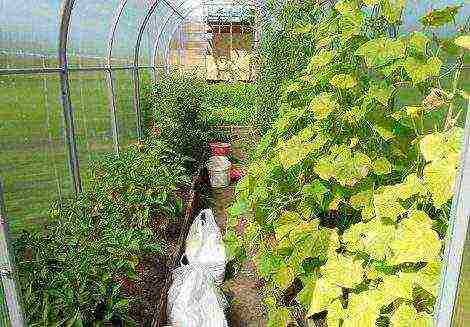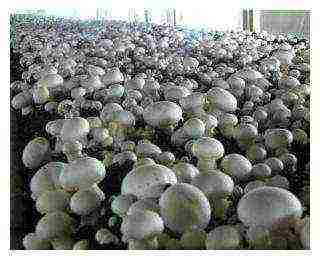Content
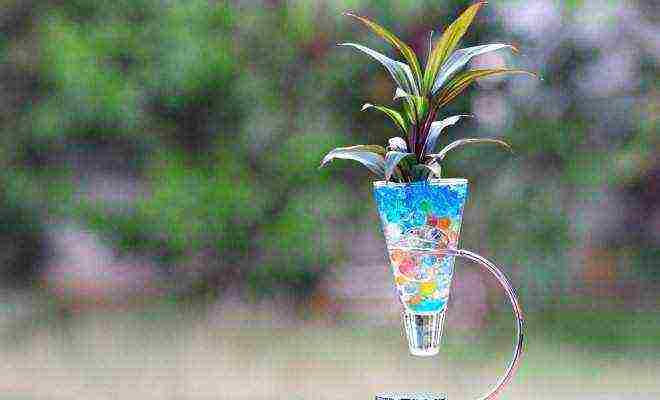
The hydrogel is capable of absorbing and retaining moisture for a long time, which makes it very useful in the flower industry. How can the substance be used?
Hydrogel is a polymer compound that is actively used in agriculture, and recently flower growers and phytodesigners have also paid attention to it. Plants can be planted directly in the hydrogel, or you can mix the substance with soil for indoor flowers. The liquid that the hydrogel absorbs does not evaporate or flow onto the tray, and also does not lose nutrients.
Planting plants in a hydrogel
A plant in a hydrogel can become not just an interior decoration, but also an excellent gift, because it looks very original. The hydrogel is commercially available in various colors, so it can be used to create a very bright and beautiful composition. The cost of the substance is not very high, and its consumption is quite small, so one sachet will be enough for a long time.

Hydrogel granules
Tableware. Containers for planting plants should be chosen transparent so that the balls or pieces of hydrogel are clearly visible. As for the shape of the vessels, it can be absolutely any (when planting plants in a hydrogel, the possibility of damaging the roots is minimized). For small plants growing in rosettes, glass goblets can be chosen, and for larger specimens, round or cylindrical vases are suitable.
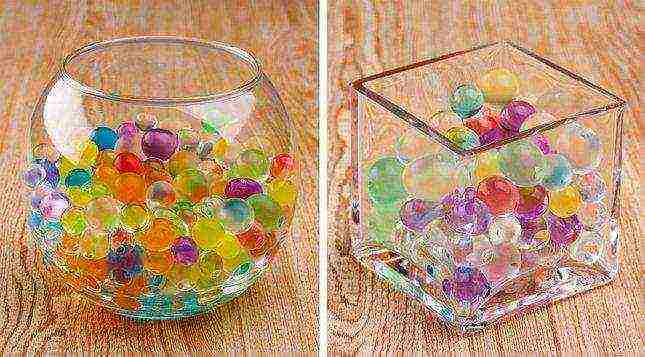
Glass containers with hydrogel
Hydrogel preparation... You need to fill in the hydrogel with clean water suitable for irrigation (settled, distilled). For 1 g of dry matter, about 300 ml of liquid can go away. It is best to look at the required proportions on the packaging.

Hydrogel
What plants can be grown in a hydrogel? Grow well in polymer absorbent shefflera, chlorophytum, dracaena, tradescantia, syngonium, cordilina, scindapsus... Suitable for shaded corners of the apartment spathiphyllums, ficuses and sansevieria... Some growers grow flowering plants in hydrogel: Kalanchoe, Guzmania, Tilandsia and anthurium.
Do not plant flowers in the hydrogel that do not need frequent watering. For example, most succulents and epiphytes store moisture in leaves and roots, and being in a humid environment will cause them to rot.
Landing. Planting flowers in a hydrogel does not fundamentally differ from planting in ordinary soil. First, the roots of the plants must be rinsed well under running water so that no parts of the old soil remain on them. Next, the container for planting must be filled with a hydrogel, the plant should be placed in it and a little more substance added. That's all, nothing complicated. The only thing to watch out for is to keep the plant upright (this can be a problem as the hydrogel is very slippery).
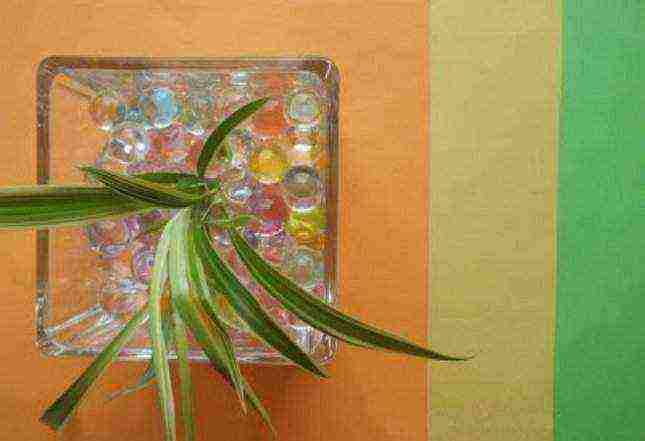
Plant in hydrogel
Features of care. Watering a plant planted in a hydrogel should be 6 times less frequent than plants in soil. The substance itself will tell you about the need for watering, which will begin to settle a little - this means that a lot of moisture has begun to leave it.
Planting plants in soil with hydrogel
Planting indoor flowers in such a soil greatly facilitates their care, because such plants can be watered less often.In addition, the hydrogel helps plants adapt to new conditions faster after transplanting.
How to properly formulate a hydrogel substrate?
1. The first step is to mix the substance with a suitable substrate. For 1 liter of soil, only 2-3 g of hydrogel is required.
2. Then the granules should be mixed well with the earth.
3. Now the resulting mixture must be watered abundantly so that it is well saturated, and the hydrogel has absorbed the required amount of moisture. Now plants can be planted in such land.
The hydrogel in the substrate retains its qualities for 3-5 years, so it is enough to add it to the ground once during planting.
What plants can be grown in a hydrogel? For growing in a hydrogel substrate, moisture-loving plants are suitable, as well as species that are suitable for growing in hydroponics. So, you can plant in soil with polymer chlorophytum, ivy, codiaum, kalanchoe... Some growers even grow succulents like this, for example, fat woman or spurge... And beautifully flowering Saintpaulias, petunias, gloxinias, when planted in a substrate with a hydrogel, even begin to grow more intensively and bloom more abundantly.
Features of care. Caring for plants planted in the ground with the addition of hydrogel granules is practically no different from ordinary care. The only thing to remember is not to water the plants too often.
Flowers and plants grow beautifully in a hydrogel. Having studied the opinions and reviews, I came to the conclusion that water and fertilizing are the main requirement, and sometimes the soil is not needed at all ...
One of the innovations in the field of growing indoor flowers and using them as decorative accents in the interior is crystalline soil (hydrogel). It allows you to grow plants without using soil in glass vases and transparent vessels.
A vessel with a plant and crystalline soil looks absolutely stunning - especially if you use a backlight or put it on a window. What kind of miracle is this, crystalline soil? Let's figure it out together!
How does a hydrogel work
It is a polymer that absorbs moisture in a volume 80-150 larger than its original size. It retains moisture for a long time, giving it to the roots of the plant.
Together with moisture, it gives off nutrients that contribute to the long-term preservation of the plant. In a granule of crystalline soil there are microscopic holes that trap air and water.
Use and care
What is it for: Crystalline soil or hydrogel is a moisture-absorbing polymer (polyacrylamide) that can absorb 80-150 times its original size of water and retain moisture for a long time.
Method of use - just pour into a vessel and fill with water for 6-8 hours. In warm water, the hydrogel will swell faster. Caring for the hydrogel is simple - it only requires adding water from time to time as it evaporates.
How to plant plants
To plant plants in crystalline soil, you need to carefully and thoroughly clean the roots from the earth. Many plant species can exist in a hydrogel - they are listed below.
Those plants that grow in hydroponics are able to survive in crystalline soil. It is not recommended to plant cacti, succulents and orchids, and other flowers that are afraid of a large amount of moisture.
Which plants are suitable
Indoor plants suitable for growing on crystalline soil: Dieffenbachia, Dracaena, Caladium, arrowroot, Philodendron, Fittonia, Chlorophytum. You can try any plant that takes root in water.
Video instructions
It is considered by the example of planting violets in a hydrogel.
Modern technologies do not stand still, not only in relation to gadgets, but even in crop production. One of these ultra-fashionable novelties is the cultivation of plants and flowers on a hydrogel.
This substrate began to be used in agriculture, and only a few years later the advantages of planting indoor plants in it were discovered.
A hydrogel (or aqua soil) is a jelly-like mass of small grains. This polymer does an excellent job of retaining moisture, absorbing and transferring it to plants. By itself, it does not have a definite shape, which helps to fill a vessel or flowerpot with it, even the most bizarre shape.
Aqua primer does not have an attractive color (when dry it is white), but it is easily painted in bright colors. You can give it an attractive look both with natural food colors and juice of vegetables or berries (for example, blueberry or beetroot).
Growing plants and flowers on a hydrogel, the advantages of a hydrogel:
- It easily holds a large amount of water - only 10 grams of a substance can absorb up to 2 liters of liquid. This advantage is especially noticeable in the absence of the possibility of timely watering.
- It is an environmentally friendly and safe substance.
- The hydrogel can be used as an additional medium for growing plants in soil, as well as a substitute for soil for decorative indoor flowers.
- Vases with hydrogel, unlike conventional ground fillers, serve as an original addition and decoration of interior design
- Can be used as a transport material when transporting plants over long distances.
As with everything, aqua soil has disadvantages:
- Not all plants can be grown in a hydrogel without adding soil; Most pets are not comfortable in it, since in addition to water they require feeding and fertilization
- The material is not durable and loses its properties
- Do not expose the hydrogel to direct sunlight.
Aqua soil is used for:
- decorative growing of flowers at home
- for adding to the soil when planting plants outdoors
- for germinating seeds
- as interior decoration
Using a hydrogel as a primer additive
This method will work for many plants as they will benefit from both aqua soil and soil.
For planting, use a mixture in the ratio of 1 liter of soil to 1 gram of gel.
The hydrogel granules are poured with clean water and left to infuse.After contact of the substrate with the liquid, it swells and increases in volume several times. After a few hours, the excess water must be drained, and the hydrogel must be mixed with the prepared soil. It is ready for planting a plant in it.
Such soil perfectly retains water and nutrients, nourishing the roots of the plant. It is used for planting ferns, ivy, ficus, dieffenbachia and others.
Use of pure aqua soil
The substrate will serve as an additional decoration for the interior, but, unfortunately, not all plants are suitable. The main condition for the use of a hydrogel is the absence of a drainage hole in the container with it. And not all flowers can develop in such an environment. In addition, it does not tolerate direct sunlight, which means that the plants living in it should also prefer shade.
It is best to use a pure hydrogel for moisture-loving greens with no special nutritional requirements.
Aqua soil is a novelty of modern gardening and plant growing. It is widely used outdoors, adding ornamental plants to the soil, and also as an independent material. Due to the possibility of giving it colorful shades, hydrogel is actively used as a decoration for compositions of flowers and original gifts.
